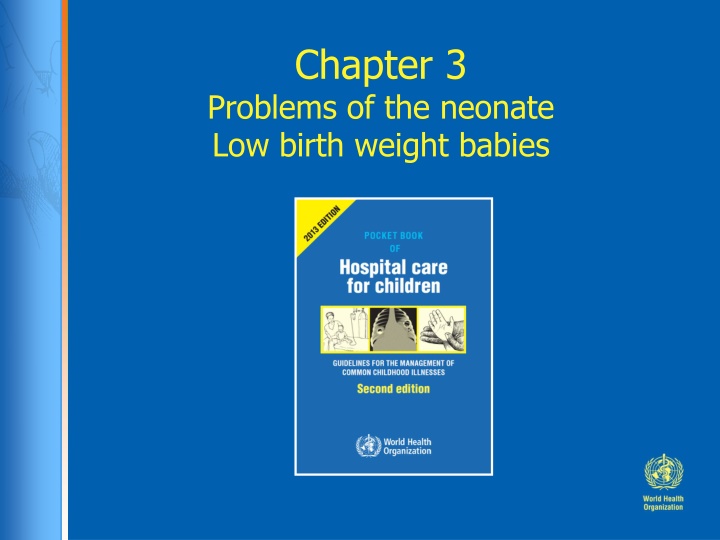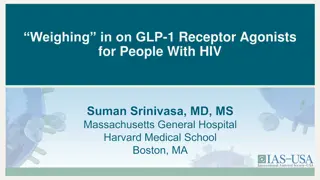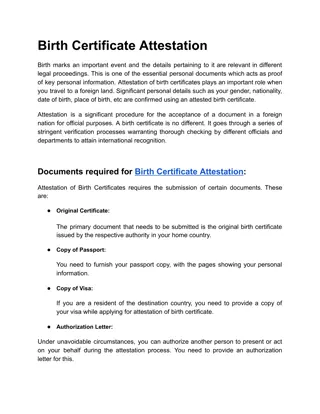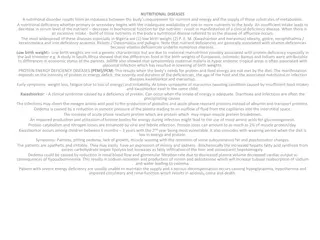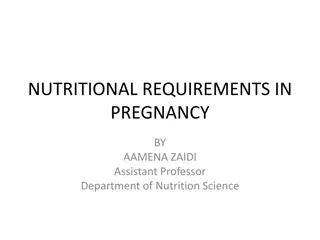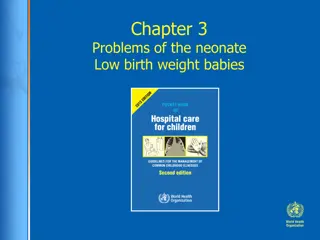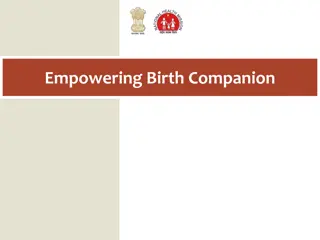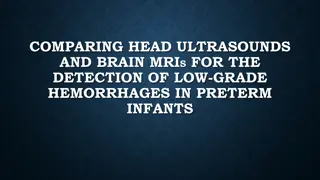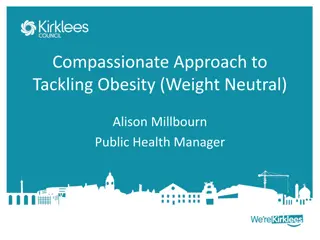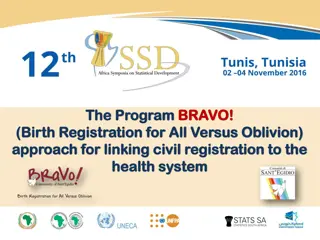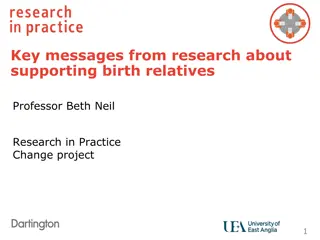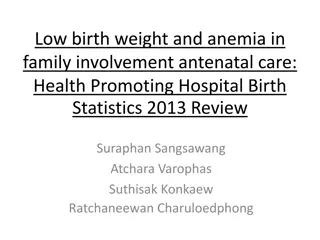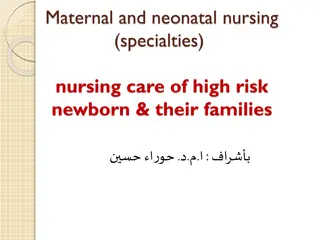Immediate Care for Low Birth Weight Neonate: Baby Jonah Case Study
This content provides a case study of Baby Jonah, a low birth weight neonate born at 30 weeks with various emergency signs. It discusses the stages in the management of sick newborns, emergency measures needed, assessment at delivery, and neonatal resuscitation techniques, emphasizing the importance of prompt and appropriate care for such fragile infants.
Download Presentation

Please find below an Image/Link to download the presentation.
The content on the website is provided AS IS for your information and personal use only. It may not be sold, licensed, or shared on other websites without obtaining consent from the author.If you encounter any issues during the download, it is possible that the publisher has removed the file from their server.
You are allowed to download the files provided on this website for personal or commercial use, subject to the condition that they are used lawfully. All files are the property of their respective owners.
The content on the website is provided AS IS for your information and personal use only. It may not be sold, licensed, or shared on other websites without obtaining consent from the author.
E N D
Presentation Transcript
Chapter 3 Problems of the neonate Low birth weight babies
Case study: Jonah Baby Jonah just born at 30 weeks gestation. Weight is 1.4kg He is floppy, with slow respiratory rate, brief periods of apnoea, and heart rate of 80/min. The mother had no antenatal care and rupture of membranes for 26 hours prior to delivery.
Stages in the management of a sick child (Ref. Chart 1 p.xxii) 1. Triage 2. Emergency treatment 3. History and examination 4. Laboratory investigations, if required 5. Main diagnosis and other diagnoses 6. Treatment 7. Supportive care 8. Monitoring 9. Discharge planning 10.Follow-up
What emergency or priority signs does baby Jonah have?
Triage Priority signs (Ref. p. 6) Tiny baby Temperature Trauma Pallor Poisoning Pain (severe) Respiratory distress Restless, irritable, lethargic Referral Malnutrition Oedema of both feet Burns Emergency signs (Ref: p2,6) Obstructed breathing Severe respiratory distress Signs of shock Coma Convulsing Severe dehydration
Triage Priority signs (Ref. p. 6) Tiny baby Temperature Trauma Pallor Poisoning Pain (severe) Respiratory distress Restless, irritable, lethargic Referral Malnutrition Oedema of both feet Burns Emergency signs (Ref: p2,6) Obstructed breathing Severe respiratory distress Signs of shock Coma Convulsing Severe dehydration
What emergency measures are needed for this newborn baby?
Assessment of newborn at delivery Dry and stimulate baby with clean cloth and place where the baby will be warm Look for: Breathing or crying NO Good muscle tone NO Colour pink NO
Neonatal resuscitation Use a correctly fitting mask: If the baby is still not breathing after opening the airway (Ref. p. 47): Check position and mask fit Give breaths at rate of 40 breaths per minute, watch the chest rise, but be gentle and do not overinflate Use oxygen if available Every 1-2 minutes stop and see if the breathing and pulse have improved
Neonatal resuscitation Check the heart rate (HR) What do you do next? Based on Jonah s heart rate of 80 per minute
Further assessment After further brief resuscitation for 30 seconds with bag and mask, Jonah has regular breathing and the heart rate was 120/minute. Mild chest indrawing, SpO2 91% on 0.5 l/min oxygen
Early Essential Newborn Care Dry with a clean cloth Maintain skin-to-skin contact Give the baby to mother as soon as possible, on chest or abdomen Cover the baby to prevent heat loss Breastfeeding Start breast feeding in the first hour Keep mother and baby together Further Management: Give vitamin K (phytomenadione) 1 ampoule IM Apply antiseptic ointment or antibiotic eye drops (e.g. tetracycline) to both eyes once Cord care chlorhexidine swab Examination and weight
Treatment of VLBW babies Definitions: LBW = 1.5-2.5 kg VLBW = 1-1.5 kg ELBW = <1 kg
Management of VLBW babies Keep warm: temperature 36-37 C (Ref p.58) Do not separate from mother, unless baby critical Oxygen if needed - via nasal prongs Target SpO2 88-95%, not higher Commence breast milk feeding (including colostrum) via NG tube if cannot suck IV glucose / saline if cannot give milk Fluid 60ml/kg/day on first day of life How many ml/hour for Jonah? Aminophylline (or caffeine) for apnoea Penicillin and gentamicin if signs of infection Phototherapy if jaundice Vitamin K, BCG, Hep B, cord care
Investigations Full Blood Examination Haemoglobin: 160 gm/L (145 - 225) Platelets: 175 x 109/L (84 478) WCC: 5.1 x 109/L (5 25.0) Neutrophils: 2.1 x 109/L (1.5 10.5) Lymphocytes: 3.0 x 109/L (2.0 10.0) Blood glucose: 3.8 mmol/l (2.5 5.0) Blood culture: No growth
Progress On day 2 Jonah s condition was better. Eyes open and active. RR is 46/min with mild chest indrawing, SpO2 94% on air. His abdomen was soft and passed meconium. Stayed with mother for skin-to-skin contact Commenced feeding with expressed breast milk (EBM) 3 ml every 2 hours by nasogastric tube. What is the target feed for Jonah? (Ref p. 57 and 60) 90ml/kg/day, Jonah is 1.4kg, 2 hourly feeds (90 x 1.4) / 12 = 10.5 ml every 2 hours
Progress The next day he looks lethargic and jaundiced and has some further apnoea. SpO2 82%. His abdomen was distended and there was bile stained nasogastric aspirate.
What may be the cause of this deterioration? What investigations you will do?
Investigations Full Blood Examination Haemoglobin: 110 gm/L (145 - 225) Platelets: 57 x 109/L (150 400) WCC: 3.1 x 109/L (5 25) Neutrophils: 0.9 x 109/L (1.0 8.5) Lymphocytes: 2.2 x 109/L (2.0 10.0)
Investigations Blood glucose: 3.2 mmol/l (3.0-8.0) Bilirubin: 310 mol/L Abdominal X-ray
What may be wrong? How will you manage the baby?
Progress Likely diagnosis is necrotising enterocolitis (NEC). Jonah s feeds are withheld. 10% glucose + NaCl was given intravenously. Metronidazole added to benzylpenicillin and gentamicin. Oxygen Aminophylline was continued for apnoea Phototherapy for jaundice.
Test What complications might occur in a VLBW baby? Gastrointestinal Feeding intolerance Necrotising enterocolitis General Hypothermia Hypoglycaemia Infection Anaemia Jaundice CNS Intracranial haemorrhage Developmental problems Respiratory Apnoea Hypoxaemia RDS
What complications did occur? General Hypothermia Hypoglycaemia Infection Anaemia Jaundice (p.64) Gastrointestinal Feeding intolerance (p.60) Necrotising enterocolitis (p.62) CNS Intracranial haemorrhage Developmental problems Respiratory Apnoea (p.61) Hypoxaemia RDS
Summary and progress Baby Jonah was delivered prematurely. He needed brief resuscitation after birth. He was commenced on oxygen, antibiotics and IV fluid. He had some apnoea early but these improved with aminophylline. He developed necrotising enterocolitis after commencing feeding on the 2nd day of life. This was treated with a change in his antibiotics for 10 days and stopping feeds for 5 days. Breast milk feeds were restarted after 5 days and slowly increased. This time feeds were well tolerated and his feeding volume was gradually increased to 180ml/kg/day over 10 days. He was discharged when he tolerated breast milk well and had reached a weight of 2kg.
Follow-up of high-risk newborns review monthly and check for Nutrition and growth Monitor the child s growth chart each month (weight, length and head circumference Mothers may have limited milk supply, breast feeding counselling and support / Susu Mamas Multivitamins and zinc Anaemia Iron deficiency common, start iron when babies 6 weeks of age Check for development complications Cerebral palsy, visual and hearing problems Infections Pneumonia, bronchiolitis and diarrhoea more common
